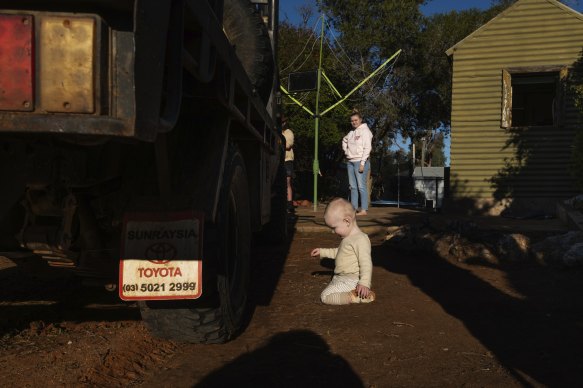This was published 9 months ago
Editorial
In Broken Hill as in Sydney, the answer is housing
Whether you’re out for dinner or at children’s weekend sport, you can bet at some point the conversation will turn to housing and how costly it is.
But where one can afford to live is also a hot topic 13 hours’ drive west of the state’s capital, where poor quality housing is one of several factors contributing to a looming health crisis.

Makaydee Leayr and her son, Marcus, are among the residents of Broken Hill living in homes contaminated by lead. Credit: Rhett Wyman
As Angus Thomson reports in The Sun-Herald today, the level of lead in the blood of children aged under five in Broken Hill is on the rise again, despite decades of remediation efforts in the town built on one of Australia’s richest mines.
The latest monitoring figures, released by Far West Local Health District in August, showed the average blood lead level for children aged between one and five had increased.
At a minimum, such levels present risks for children’s cognition and motor function. As levels increase, the body’s ability to use vitamin D and make red blood cells can decrease. In extreme cases, high lead levels can cause severe anaemia, kidney damage and seizures.
For Aboriginal children, the average blood lead reading was 7.9 micrograms per decilitre, a reading well above the 5 microgram target set by the National Health and Medical Research Council. It is alarming that one in 10 Aboriginal children had blood lead levels four times this target, measuring above 20 micrograms.
Public health physician Hugh Burke, who has been working with the Maari Ma Health Aboriginal Corporation in Broken Hill on the lead issue for 30 years, is right to say the figures show NSW is hardly “closing the gap” when it comes to Indigenous health, especially for vulnerable children.
The gap in life expectancy between Indigenous and non-Indigenous men and women born in Australia between 2020 and 2022 was 8.8 years and 8.1 years, respectively.
It is concerning that the Productivity Commission recently forecast that the nation will fall short of its goal of closing this gap by 2031.
An Australian Institute of Health and Welfare analysis of ABS health survey data from the years before the pandemic estimated only 29 per cent of Aboriginal and Torres Strait Islander adults aged 18 to 64 were in “good health”, compared to 51 per cent of non-Indigenous Australians.
Who is working to reduce – and eliminate – this gap?
Questions have been raised about the Aboriginal Health and Medical Research Council of NSW, the peak body overseeing local organisations such as Maari Ma.
Last month, the Herald revealed a string of issues at the council, which receives $11 million a year in taxpayer funding to represent and manage health services in some of Australia’s most disadvantaged communities.
Among the issues reported were delays to payments to service providers, and eyebrow-raising spending, including $600 invoices to cover sandwiches for six people.
Maari Ma chief executive Richard Weston said the council’s leadership had failed to honour the passion Indigenous health workers had for their work and communities.
More must be done in Broken Hill, beginning with a step already advocated for by the community. As Thomson reports, a lack of social housing is keeping families in poor quality private rentals, where the only place to play is in the dirt, and lead is being detected in carpets and paint.
The state’s Aboriginal Housing Office has recently completed 10 new homes in the town, with three more on the way. But, as its babies crawl in contaminated dirt, Broken Hill needs better protection from the lead dust that risks poisoning their children and their community’s future.